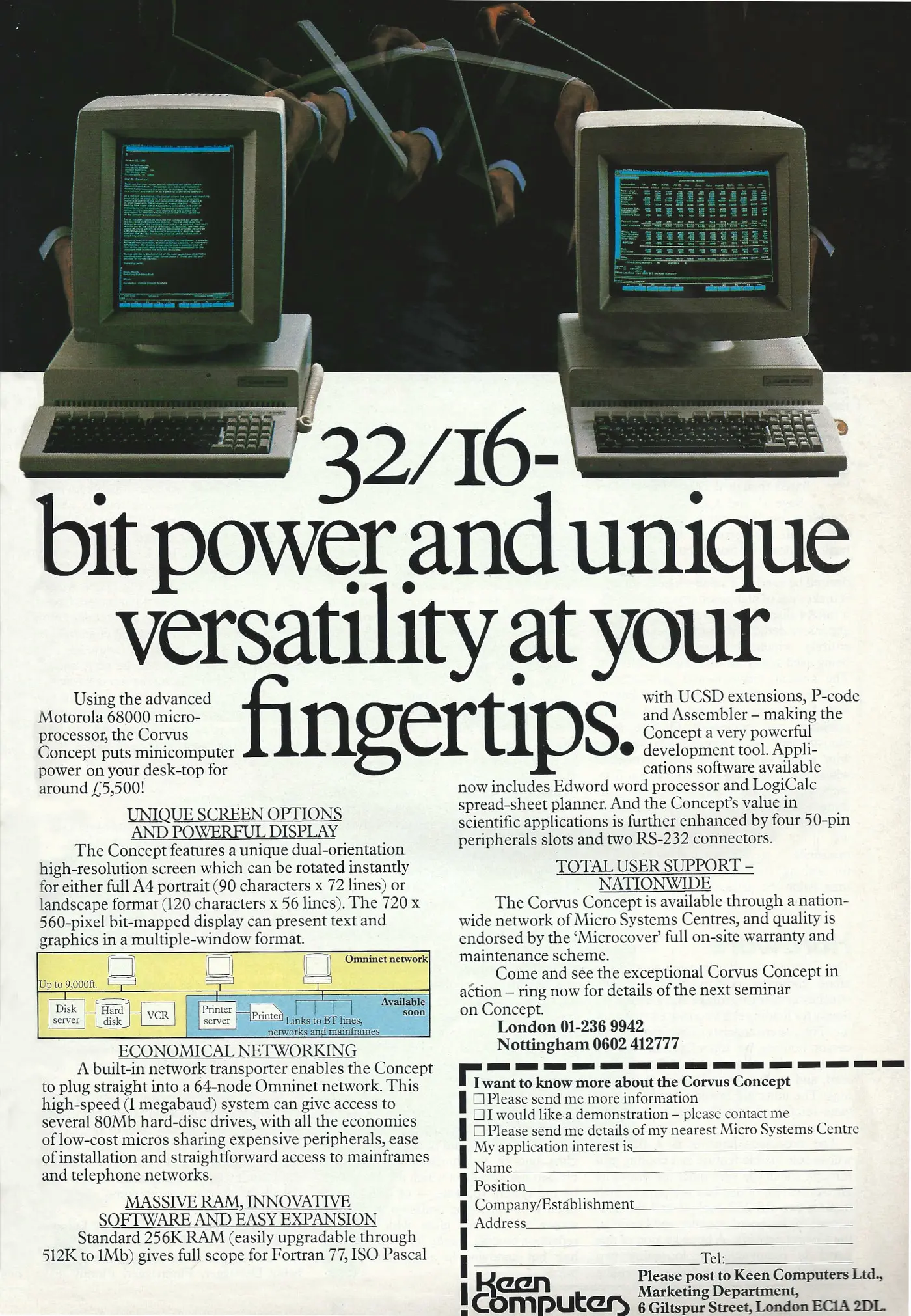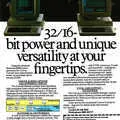Corvus Advert - March 1983
From Personal Computer World

32/16-bit power and unique versatility at your fingertips
The Corvus Concept was one of several 32/16-bit machines appearing at the time, like the Fortune 32:16 or Sage II, in an era when 16-bit machines were only really getting going and 8-bit home computers were still very much the norm.
The 512K model with a hard disk retailed for around £8,490 (£37,500 in 2026), ran a Motorola MC68000 processor (the same as found on the Commodore Amiga, Atari ST and Apple Mac) and was designed from scratch as a powerful, fully networked workstation.
The Concept had debuted the year before when a prototype version first appeared in the spring of 1982.
It had, according to Mark Hahn, Corvus's VP of research and development, been developed as an executive workstation along the lines of a Model T Ford, i.e. as a standard, with Hahn saying that it was designed:
"by considering what the user looks for in a computer system, not what we thought the system should be ... it will be to this generation what the Apple II was to the 8-bit generation"[1].
It also came with an unusual A4 monitor configuration that could be rotated to either landscape or portrait, a feature which was normally only found on dedicated word-processor systems.
This was thanks to its 16/32-bit processor and its use of large amounts of cheap memory, which meant that the Concept could use a software character generator which could produce its character set in either orientation.
The Concept was an early example of a computer that was entirely hard-disk based - in this case offering a Winchester drive in 6, 10 or 20MB - using retro 8" floppies only as a means of transferring data or software.
It was also notable for the fact that despite running a 68000, it provided four expansion slots that were fully Apple compatible, even though the Apple ran the MOS 6502.
It was even possible to plug the Corvus's hard disk into an Apple, with the only limitation that any 6502-specific code wouldn't run.
The Concept was reviewed by Dick Pountain in March 1983's Personal Computer World, with a machine supplied by Corvus's UK distributor, Keen Computers. The review concluded:
"As a stand-alone computer the Concept is a refined but rather expensive way to go, probably one for the MD to have as a status symbol, though a work-at-home Pascal programmer or word processor could find it a good investment if sufficient funds are available. As a hope for the future, I would like to see Corvus introduce a multi-tasking version of Merlin/CCOS [its Operating System] to take full advantage of the 68000's power and allow real multi-window working along Xerox Star lines[2].
Corvus was also somewhat famous for its early network, the Corvus Omninet - a system which became the first commercially-successful network at a time when its rival Ethernet cost upwards of $1,000 per terminal.
This had been used on machines like NCR's Decision Mate 5 (where it was offered re-badged as an NCR network) and even on the IBM PC, where Keen Computers was hoping to re-sell the Omninet through IBM micro dealers[3].
A new, high-performance, Omninet was said by Keen to be able to link more than 60 IBM PCs over 4,000 feet.
The Omninet could shift data around at the rate of "10 A4 pages of text from one PC to another in one tenth of a second"[4], which works out at about 1mbps.
In the autumn of 1983, Corvus was claiming that the Omninet had become "the de-facto standard", with over half the installed base of networks being either Omninet or its previous version, Constellation. The list of licencees was over 20 and included DEC, Victor and Texas Instruments.
In the same month it also announced its new mass-storage device, called "The Bank". This was a 100-track video-tape-based storage device, said by Personal Computer News to resemble a "giant Microdrive" - Sinclair's erstwhile stringy floppy storage system.
However, unlike the serial Microdrive, The Bank could randomly access files on its endless-loop 100MB or 200MB tapes in no more than ten seconds, a speed comparable with floppies but on a device with significantly more storage than hard disks of the time.
The Bank retailed for £1,950, or around £8,610 in 2026 money, with a 100MB tape thought to be around £25-£50 (£110 - £220)[5].
Corvus, founded in 1979, filed for Chapter 11 bankruptcy in 1987, although it was still operating at least until the spring of 1988, at which point it had become profitable again after a few years of financial hardship.
Its problems could be traced back to the timing of the launch of its Concept micro, which came at around the same time as the soon-to-be dominant IBM PC was unleashed onto the market.
Unfortunately, the Concept used a proprietary operating system and so was not compatible with PC-DOS (MS-DOS), whilst the Omninet networking system - although usable on the IBM PC - was not compatible with Ethernet, which would eventually become the de-facto networking system in the PC world.
Corvus then decided to go on a spending spree and ended up buying Omtek, an IBM clone manufacturer, just before the clone market became super-competitive, crowded and generally unprofitable.
It also purchased Unix systems purveyor Onyx, which itself had previously merged with Winchester disk manufacturer IMI, which was no doubt handy as IMI drives were used by Corvus.
By 1985, although sales were still growing, Corvus started losing money for the first time in its history. It was also said to be losing market focus and was seen to be trying to cover the entire networking market without really understanding it.
Onyx was closed down, with its remaining inventory being sold off, whilst the company exited the microcomputer business entirely in 1987. It also shed staff and reduced its expenditure by around 23%.
It also "reaffirmed its commitment" to the networking market - and addressed its lack of compatibility with the IBM PC - by launching PC/NOS, an IBM-compatible network which had been originally developed by another Corvus acquisition from 1986, Applied Intelligence Incorporated.
The company also launched it Omninet/4, a 4mbps twisted-pair network which worked on the IBM PC and its clones, and also announced its support for Lan Manager - the server-side networking software for OS/2 PCs - moves which helped it turn a loss of $1.1 million in 1987 to earnings of about $3 million in 1988[6].
Despite the return to profit, Corvus had filed for Chapter 11 bankruptcy protection in 1987 and eventually fizzled out in the early 1990s[7].
Date created: 08 September 2014
Last updated: 06 November 2025
Hint: use left and right cursor keys to navigate between adverts.
Sources
Text and otherwise-uncredited photos © nosher.net 2026. Dollar/GBP conversions, where used, assume $1.50 to £1. "Now" prices are calculated dynamically using average RPI per year.

